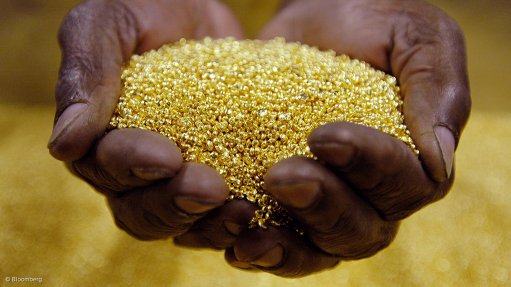
Photo by: Bloomberg
JOHANNESBURG (miningweekly.com) – ASX- and TSX-listed Perseus Mining on Monday reported “encouraging” assay results from recent infill drilling on the Mampong deposit at its Edikan gold mine, in Ghana, West Africa.
The assay results represented the initial drilling results from a planned 5 560 m infill drilling programme. The programme was about half complete, with 2 584 m of reverse circulation and 161 m of diamond core tails drilled to date.
Further, the Mampong infill drilling programme formed part of a broader near mine exploration programme intended to identify higher-grade mineralisation that had the potential to improve the head grade of mill feed at Edikan.
Perseus MD Jeff Quartermaine said: “The drill results announced today are very encouraging in this context and we will be looking forward to additional success when the remainder of the Mampong drilling programme is completed in coming months.”
The southern, higher-grade portion of the Mampong deposit is the subject of the current infill drilling programme. The two Mampong zones were previously drilled in several campaigns during 2008 through 2010 to a nominal drill spacing of 40 m X 40 m, resulting in the present inferred mineral resource.
The current 5 560 m programme was planned to infill previous drilling to a drill spacing of about 20 m X 20 m on the southern higher-grade portion of Mampong to better define that portion of the mineral resource and upgrade it to an indicated mineral resource for inclusion into the Edikan gold mine ore reserves and life-of-mine plan.
Results had been received for 33 of the 40 holes drilled in the programme.
Although most of the drill intercepts were in line with those from past drilling, several exceptionally high-grade intercepts suggested potential for delineating pockets of high-grade mineralisation and improvement of the overall grade of the southern Mampong resource, which could elevate it to a priority mining target given its proximity to the Edikan plant site.
“The positive results at Mampong come on the back of recent drilling success at the Bokitsi deposit where the overall gold grade of the measured and indicated mineral resource was successfully increased to 3 g/t,” explained Quartermaine.
Meanwhile, Perseus noted that the programme would resume shortly and be completed next month after the drill rig tested the Agyakusu anomaly north-east along strike from Fobinso and completed a small programme of infill and extensional drilling immediately south of the main Bokitsi South high-grade lode.
The Mampong deposit is between 700 m and 2 100 m south-west of the operating Abnabna pit at Edikan. The deposit consists of two mineralised zones, including a wider, lower-grade zone to the north that represents the south-western strike extension of the Abnabna-Fobinso gold-bearing granite and in the south, a narrower, higher-grade zone that is hosted in a separate 10-m- to 15-m-wide granitic dyke about 200 m south-east of and parallel to the Abnabna-Fobinso granite.
The two mineralised zones at Mampong presently contain an inferred mineral resource of 8.6-million tons at 0.9 g/t for 257 000 oz of gold.
Mineralisation at Mampong is essentially the same as that in the Abnabna-Fobinso deposits and consists of stockwork quartz, veining in altered granite with trace to several per cent disseminated pyrite plus arsenopyrite.
Quartermaine pointed out that Perseus was committed to a corporate strategy of organically growing cash flows through successful exploration, leading to project development and efficient operation of multiple gold mining operations in a range of geopolitical settings in West Africa.